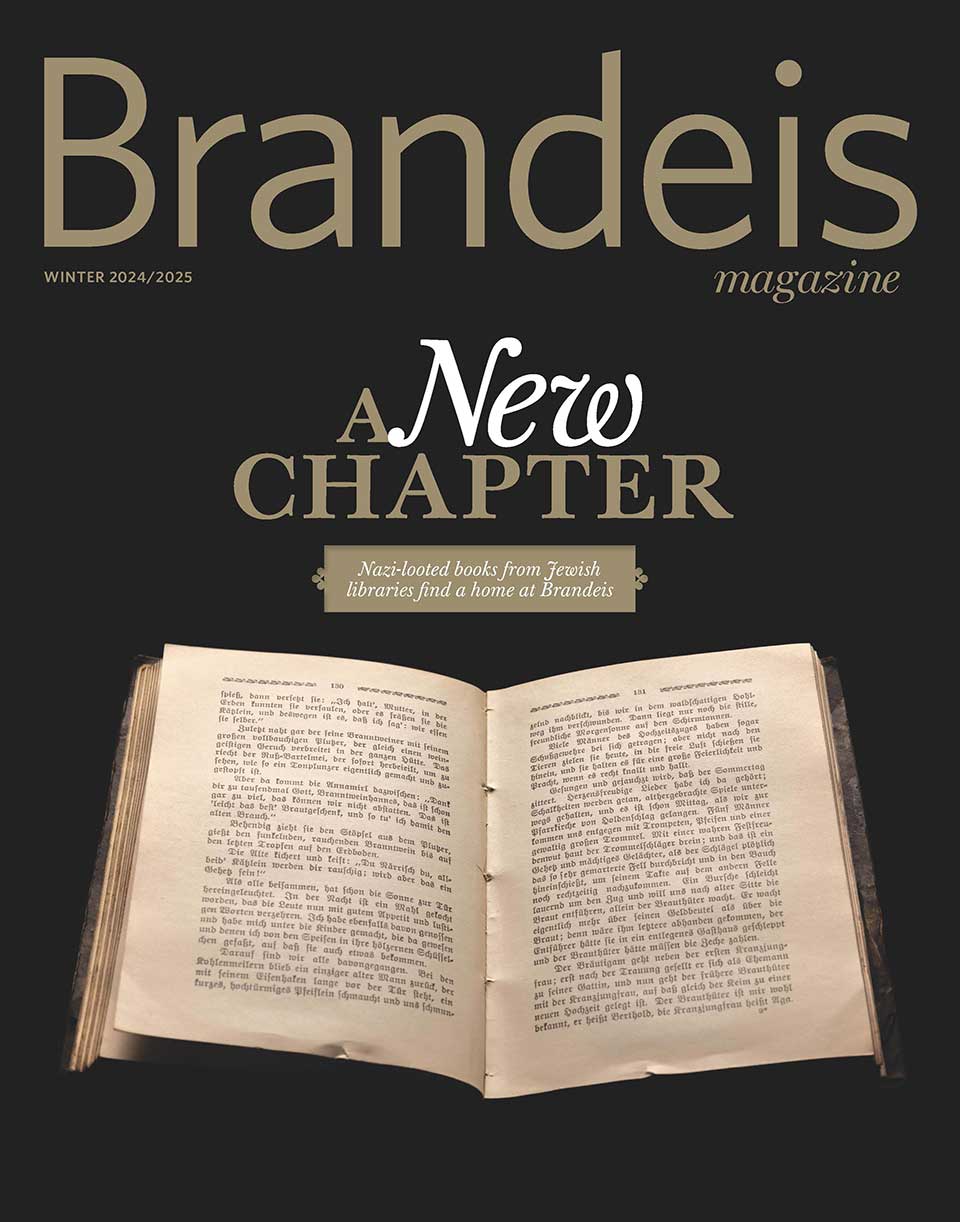Burying the Past Is Not an Option
Conceptual artist Karen Frostig is spearheading a memorial project in Latvia, where her grandparents were among thousands of Jews murdered by the Nazis.
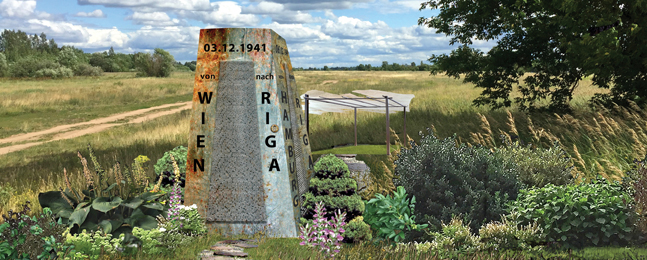
Courtesy Karen Frostig
A proposed design for the Jungfernhof memorial, digitally inserted into a photo of the existing site.
by Lawrence Goodman
In early 2019, Karen Frostig traveled to Latvia to visit the place where the Nazis had murdered her grandparents.
She drove a few miles outside the capital city Riga to the site of the Jungfernhof concentration camp, to which nearly 4,000 Jews were deported between 1941-43. Most of them were killed within two months of their arrival.
The site, located alongside the gently flowing Daugava River, is now a recreation park. A banner with the park’s name, Mazjumpravmuiža Manor, welcomed visitors. A cloudy blue sky was filled with geese. A few people walked the river promenade. Occasionally, a bicyclist or a rollerblader buzzed by.
“I had this feeling of being robbed,” says Frostig, a multimedia artist who is an affiliated scholar at the Women’s Studies Research Center at Brandeis and a Lesley University professor of art. “I felt like I’d lost a part of my family’s history.”
So Frostig embarked on a quest to ensure what happened at Jungfernhof will never be forgotten. She designed a memorial to the Jews killed there. Slated for completion in 2024, it will consist of a monument and a small landscaped garden beneath a canopy, which will be placed above a mass grave found at the site. The canopy will move with the wind, suggesting breath.
In this way, Frostig says, a symbol of life will fly above a place of death.
Several Brandeis faculty and alumni are involved with the memorial project, which Frostig calls Locker of Memory. Historian Jonathan Sarna ’75, GSAS MA’75, sits on the project’s board. Near Eastern and Judaic studies professor Laura Jockusch; Holocaust education specialist Cheyenne Paris, Heller MA’21; documentarian Paula Apsell ’69; researcher Evan Robins ’20; and Joanna Beata Michlic, former director of the Hadassah-Brandeis Institute’s Project on Families, Children and the Holocaust, are all members of the project team.
Brandeis’ multimedia center, the MakerLab, is helping design exhibits for a website that will offer information on the camp and a virtual tour.
“In a few years, the last Holocaust survivors will pass from the scene,” says Sarna, University Professor and the Joseph H. and Belle R. Braun Professor of American Jewish History. “It is more important than ever that we create new forms of Holocaust remembrance, not dependent upon survivors and their testimony. Frostig’s project is part of this critical effort.”
The grandparents
Beile Samuely and Moses Frostig were living in Vienna when the Nazis annexed Austria in 1938, an event known as the Anschluss. Moses was a salesman. Beile, a homemaker and the mother of three children, took care of her paralyzed mother, kept the home observant and was known for her non-alcoholic wine (she crushed the grapes herself every Friday for the Sabbath).
Their son Benjamin Wolf — Karen Frostig’s father — had earned a doctorate in law and economics from the University of Vienna in 1936. For unclear reasons — perhaps because he was a practicing Jewish lawyer, perhaps just because he was Jewish — he was arrested in 1938.
A neighbor happened to work as a guard at the prison where Benjamin was jailed. He told Benjamin he’d release him if he left Austria within 48 hours. Beile secured Benjamin a passport stamped with a red J for “Jew” — likely a counterfeit — and he left for Holland. (His siblings would escape later.)
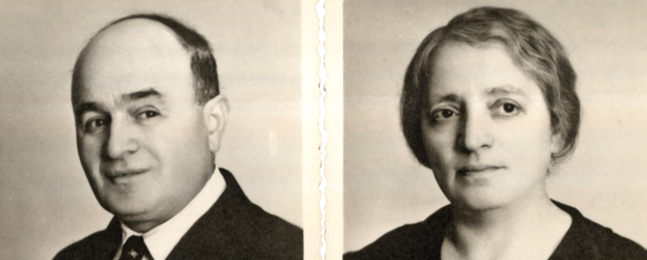
Courtesy Karen Frostig
The passport photos of Moses Frostig and Beile Samuely, Karen Frostig’s grandparents, who perished at Jungfernhof.
page 2 of 4
Beile and Moses hoped Benjamin could arrange for them to leave the country. However, his trip was arduous, taking him through Portugal and then to Cuba. He was refused asylum by Australia, New Zealand and Palestine. Finally, in 1939, he found American Jews willing to sponsor him.
Meanwhile, his parents sent him desperate letters. “Do your best, so we can get away from here because there is no life here anymore,” they wrote. But Europe was now engulfed in chaos and war. It was impossible to find a country that would accept them.
On Dec. 3, 1941, Beile and Moses were packed into railway boxcar No. 13 and transported to Jungfernhof.
The concentration camp
The transports started arriving in late November 1941. They came from Nuremberg, Stuttgart and Hamburg, in Germany, and from Vienna, carrying nearly 4,000 Jews in all.
Though it had been fallow for years, Jungfernhof had once been the site of an agricultural estate. Now the barns, stables and grain silo were used to house the prisoners. Bunks were stacked eight to 10 high, so tightly that only the top one had enough space to sit upright on.
Conditions at the camp were abysmal. In the winter, snow fell through the barracks roofs. Rations consisted of coffee; watery soup, sometimes containing a bit of cabbage or potato; a slice of bread; and, occasionally, horse meat.
The camp’s commandant, Rudolf Seck, executed prisoners himself. According to testimony from witnesses at his trial in the 1950s, he shot one prisoner for showing up a few minutes late to roll call, and another because he’d forgotten his suspenders and was holding up his pants with his hands.
In March 1942, the Nazis carried out what became known as the Dünamünde Action. Some 1,800 prisoners from Jungfernhof and another 3,000 from the Riga ghetto were taken by truck into the Bikernieki Forest and executed.
After the war ended, Jungfernhof survivors recounted this horror along with extraordinary moments of kindness and solidarity. Teachers who’d been deported to the camp held classes for the children in secret. Nothing could be written down, so the children learned arithmetic in their heads. An artist taught fellow prisoners how to model small figures in snow.
Joseph Zvi Carlebach, an Orthodox rabbi and Jewish leader from Hamburg, led clandestine funeral services and bar mitzvahs. He gathered the children to sing psalms and learn Hebrew Bible stories. The book “Jewish Everyday Life as Human Resistance, 1939-41,” contains a Jungfernhof survivor’s account of a Hanukkah party:
As we returned to the concentration camp from work, we heard that there was to be a Hanukkah party for the children in the large men’s block that evening. Rabbi Carlebach gathered all the children together. […] The wind howled […] and all was cold and bare. Everyone stood crowded around the stove, wrapped tightly in their coats. There suddenly resounded the bright voices of many children in the wretchedness and misery. […] The old familiar melodies that we once sang at home rang out.
Only 148 of the Jews taken to the camp were still alive by the end of the war.
Surprisingly, there is no entry for Jungfernhof in the online encyclopedia maintained by the United States Holocaust Memorial Museum, in Washington, D.C. Yad Vashem, the Holocaust remembrance center in Jerusalem, doesn’t have a separate listing for Jungfernhof on its website. Academics haven’t written extensively about it.
The neglect may be because Jungfernhof’s death toll is relatively small compared to that of well-known camps like Auschwitz (more than a million) and Treblinka (700,000 to more than a million). Also, Jungfernhof was in operation for only two years.
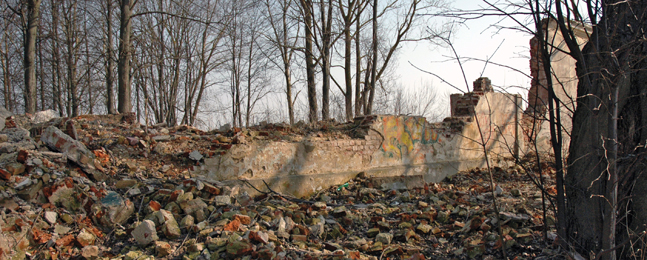
Courtesy Karen Frostig
Ruins of the Jungfernhof concentration camp.
page 3 of 4
The mass grave
During the camp’s first year of operation, 1941-42, the Riga area experienced the coldest winter on record. Wells at the camp froze. Water was retrieved from the river, but there wasn’t enough firewood to boil and sterilize it. The result was an outbreak of typhoid fever and diarrhea.
Corpses began piling up, because the ground was too frozen for the soldiers to dig graves. In February, dynamite arrived. The Germans blasted a hole and filled it with dead bodies — 800 in all — leaving them exposed until the spring, when the ground thawed and they could cover the bodies with dirt. The Germans then planted potatoes on top of the grave.
Last July, drones with high-resolution cameras buzzed overhead at the Mazjumpravmuiža Manor recreation park, and scientists used ground-penetrating radar and electrical resistivity tomography to create 3D images of the subsurface.
In just a few days, without any digging, the Jungfernhof mass grave was discovered. A team of researchers led by Richard Freund, an archaeologist and Jewish studies scholar at Christopher Newport University, in Virginia, mapped a 6-foot-deep, 7.5-meter-wide trench where the 800 bodies were buried.
Frostig and the other descendants of Jungfernhof’s victims do not know if their loved ones are interred there. The Nazis didn’t keep records.
The inspiration
Growing up, all Frostig knew about her grandparents was what they looked like. Her father hung their framed passport photos on the living room wall. Otherwise, he never talked about them or the Holocaust.
He blamed himself for failing to get them out in time, Frostig says. He wanted to forget his past. He died in 1971 when Frostig was 22.
In 1991, soon after her mother died, Frostig discovered a box of papers in the basement of the family’s home in Waltham. It contained letters from her father’s parents, his immigration records and other documents. Frostig began piecing together her family’s past.
Nearly a decade later, Frostig learned a small grove of trees across the street from her home in Newton, Massachusetts, was being cut down to make way for a new development. Somehow, she felt the destruction of the trees and the Dünamünde Action massacre in the Latvian forest were connected.
Then 9/11 happened, and Frostig began working on a multimedia art project that would tie all these events together, united around the themes of destruction and mourning. She created a series of images that blended photos of her family’s past, the Holocaust, the collapse of the World Trade Center and the grove in Newton.
The project, called Earth Wounds, culminated in a burial ceremony, in which participants reflected on loss, grief, trauma, history and environmental degradation.
In 2014, Frostig directed the Vienna Project, a commemoration of the 75th anniversary of the Anschluss. For the commemoration ceremony, she created a list of the names of Jews and others whom the Nazis killed. She then projected the names, 91,000 in total, onto the exterior wall of Vienna’s Austrian National Library.
Frostig describes her artworks as “social-action memory projects.” As part of her project in Vienna, she identified 38 sites in the Austrian capital where atrocities or acts of resistance happened during World War II. At each location, she spray-painted, “What happens when we forget to remember?”
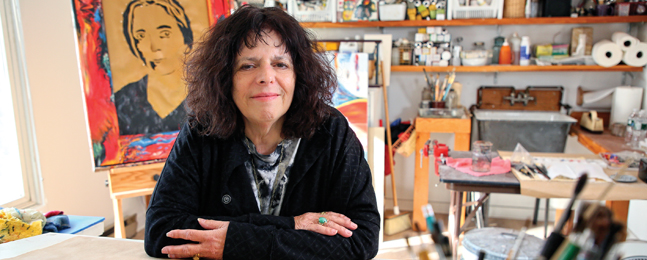
Mike Lovett
Karen Frostig
page 4 of 4
The memorial
The centerpiece of the Jungfernhof memorial will be a roughly 7-foot-high obelisk made from blackened steel, with camp victims’ names inscribed on its sides.
In addition, Hazal Uzunkaya ’14, a research technology specialist who runs the Brandeis MakerLab, has partnered with Frostig to create a series of 3D models of Jungfernhof artifacts that viewers will be able to manipulate via computer.
Frostig and Uzunkaya have already created a demo of a letter from Frostig’s grandparents to her father and plan to digitize family heirlooms from the descendants of other Jungfernhof victims. The exhibits will be included in an app and posted on the website dedicated to the camp. Uzunkaya is also creating an interactive virtual-reality tour of the camp, which will offer a better sense of what Jungfernhof was like than the black-and-white photographs that exist can convey.
Creating these kinds of exhibits involves a delicate balance, Uzunkaya says. You have to engage and involve people, but not “Disneyfy” the experience and violate the sanctity and memory of the victims.
The Latvians
From the end of the war until the early 1990s, the Soviets used the former Jungfernhof grounds, some 500 acres, as a military installation. According to Ilya Lensky, director of Jews in Latvia, a museum in Riga, this “made it impossible to conduct any explorations and build a memorial there.”
Frostig disagrees with this assessment of the past. “There was plenty of room to build a memorial there,” she says. “This is Latvia’s first concentration camp, located a mere 3 miles outside of the nation’s capital.”
Another obstacle arose once the Cold War ended in 1991: No one could be sure where the mass grave was at Jungfernhof. In the absence of a designated burial ground where the dead could be mourned and commemorated, Lensky says, other Latvian Holocaust sites, where the grave locations were known and which often had a higher death count, took precedence.
Latvia has 230 Holocaust sites. “We had an urgent need to commemorate other sites where we knew there were graves,” Lensky says. Riga’s government insisted a Jungfernhof memorial could be built only after the mass grave was located.
In the late 2000s, Riga’s municipal government moved forward with plans to convert the Jungfernhof area into a park, part of a larger effort to rejuvenate the surrounding working-class community. City officials also devised plans for a museum exploring Latvia’s agricultural history going back to the 1500s.
But the discovery of Jungfernhof’s mass grave changed the political dynamic. Learning the grave had been located did “not make the government happy,” Lensky says, but officials have adapted and now support going forward with Frostig’s project.
“I don’t foresee any objections that would stop [the memorial] from happening,” Lensky says.
In a similar vein, in October the Jewish Telegraphic Agency reported that Latvia’s parliament had voted to pay $46 million to the nation’s Jewish community, to compensate for property stolen from it during the Holocaust. The money will be paid annually, in $4.6 million increments, until 2032.
And yet, the JTA noted, “Latvia’s government has protested claims that its predecessors and population were partially responsible for the Holocaust. Many Latvians view their country, despite strong support for the Nazis during the war years, as a victim of Adolf Hitler’s occupation.”
The future
Frostig still needs to raise private funds to build the Jungfernhof memorial and exhibit. And intense negotiations lie ahead with Riga’s government officials over how to balance their desire for recreation space and an agricultural history museum with the obligation to honor the concentration camp’s victims.
“It must become a site that accommodates everyone,” Frostig says. “We must remember the past and make room for competing histories, addressing each perspective while preserving the truth about the past.”
